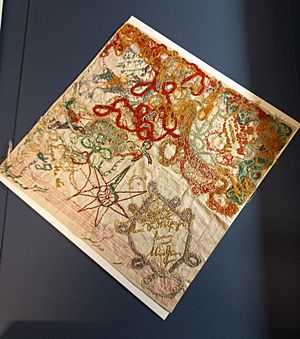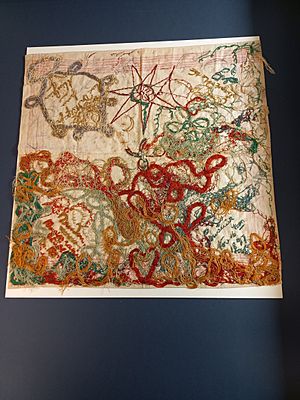Jane Grier facts for kids
Jane Grier, also known as Miss G., was an Irish artist born in 1856. She lived in Ireland and later in Dresden, Germany. She is famous for a colorful embroidered handkerchief she made while staying in a special hospital. This artwork is considered "art brut," which means "raw art" or art made by people outside the usual art world, often with unique styles.
Contents
Jane Grier's Early Life
Jane Grier was born in Longford, Ireland, in 1856. For a long time, not much was known about her. Her artwork, the "Taschentuch" (Handkerchief), was known in the Prinzhorn Collection under the name "Miss G." because of her signature. In the early 2020s, researchers finally discovered that "Miss G." was Jane Grier.
Jane lived with her mother and sister in Dresden, Germany. Her father, a naval doctor, had moved to Australia. Jane Grier traveled a lot before she entered the hospital. She studied piano at the Dresden Conservatory from 1878 to 1879. After her studies, she worked as a governess, teaching children in their homes, and as a companion in Dresden.
Her Time in the Hospital
Starting in August 1892, Jane Grier began to feel as though she was being watched. She started dressing unusually and behaved in ways that worried her family. Because of this, her family arranged for her to stay at the Royal Saxon Sanatorium and Catering Facility Sonnenstein. She was there from October 1892 to May 1893.
Jane was allowed to leave the hospital on May 23, 1893. When the hotel owner asked if she could return to the hotel, the hospital said she was "mentally unwell but not dangerous to the public." They also mentioned she needed to be cared for and kept tidy. After this, she moved to a municipal care home in Dresden. She likely returned to the Pirna-Sonnenstein sanatorium around 1897. Jane Grier died in Dresden in 1902 at the age of 46. She passed away in a municipal infirmary.
Jane Grier's Artwork
While she was in the hospital, Jane Grier started to embroider. She used a handkerchief as her canvas and first drew a design with a pencil. In her embroidery, she wrote a message to a doctor named Willfuhr, saying "Forget me not." Dr. Willfuhr was an assistant doctor at the Dresden mental hospital at that time. It's not known for sure if he was her doctor. Next to a heart made from thick red thread, you can read "Souvenir tears Nov. 16 1897." This tells us the handkerchief was made on November 16, 1897.
In 1913, a famous psychiatrist named Emil Kraepelin included the handkerchief in his textbook. He saw it as an example of the unique artworks made by people with certain mental health conditions. He thought the handkerchief showed a "loss of good taste" because of its bright colors and unusual shapes. The handkerchief eventually made its way to Heidelberg. It was sent there by Georg Ilberg, who worked with Kraepelin. Kraepelin left the handkerchief in Heidelberg when he moved to Munich in 1903. Later, Hans Prinzhorn added this artwork to his famous collection, which is now known as the Prinzhorn Collection.
In 2010, Thomas Röske, who was the director of the Prinzhorn Collection, described Jane Grier's handkerchief. He noted that it had many decorative frames, called cartouches, with written messages. He suggested that the artwork's unusual look might show a "sudden burst of resistance energy" from the artist. Another idea was that Jane Grier's desire to add more decoration became stronger than her original plan for the artwork.
Exhibitions (Selection)
- 1996/1997: Beyond Reason. Art and Psychosis. Hayward Gallery, London
- 2004–2006: Irre ist weiblich. Traveling exhibition: Prinzhorn Collection Heidelberg 2004, Altonaer Museum Hamburg 2005, Swiss Cantons Art Museum in Ittingen Charterhouse in Warth-Weiningen 2005, Muzeum Sztuki w Łodzi (Kunstmuseum Lódz) 2005/2006
- Vergissmeinnicht. Einblicke ins Anstaltsleben um 1900 ("Forget Me Not. Insights into institutional life around 1900."). Prinzhorn Collection, Heidelberg, July 8 – October 31, 2010
- Von Kirchner bis heute. Künstler reagieren auf die Sammlung Prinzhorn ("From Kirchner to today. Artists react to the Prinzhorn Collection"). May 7 – August 14, 2011
- Taschentücher: "Trost und Tränen im Quadrat" ("Handkerchiefs: 'Sadness and tears squared'"). Herxheim Museum, May 30 – September 26, 2021
- Raum der Zeichnung (Drawing Space). Port25 contemporary art space Mannheim, September 3 – November 6, 2022



